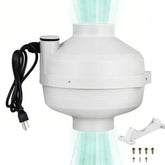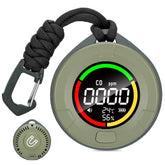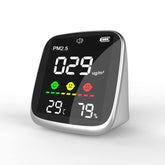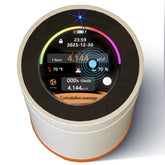Top 5 Tips to Keep Your Home’s Air Quality Safe for Your Children
Children are more vulnerable to the effects of poor indoor air quality due to their developing respiratory systems and higher exposure to pollutants. Ensuring clean air in your home is essential for their health, comfort, and overall well-being. In this blog, we’ll share the top 5 tips to maintain safe air quality for your children, along with practical steps you can take to create a healthier living environment.
I. Introduction
A. Importance of Clean Air for Children’s Health
Clean air is vital for children’s growth and development. Poor indoor air quality can lead to respiratory issues, allergies, and long-term health problems.
B. Vulnerability of Children to Poor Air Quality
-
Developing Respiratory Systems: Children’s lungs are still developing, making them more susceptible to pollutants.
-
Higher Exposure to Pollutants: Children often play closer to the ground, where dust and allergens accumulate.
C. Common Indoor Air Pollutants Affecting Children
-
Dust and pet dander.
-
Mold spores.
-
Volatile Organic Compounds (VOCs) from paints and cleaners.
-
Secondhand smoke.
-
Carbon monoxide and carbon dioxide.
II. Tip 1: Ensure Proper Ventilation
A. Open Windows Regularly
-
Allow Fresh Air to Circulate: Fresh air helps dilute indoor pollutants and improve air quality.
-
Best Times for Ventilation: Early morning and late evening are ideal, as outdoor pollution levels are typically lower.
B. Use Exhaust Fans
-
In Kitchens and Bathrooms: These areas are prone to moisture and odors, which can contribute to poor air quality.
-
After Cooking or Showering: Run exhaust fans to remove steam, smoke, and odors.
C. Install Mechanical Ventilation Systems
-
Heat Recovery Ventilators (HRVs): These systems exchange stale indoor air with fresh outdoor air while retaining heat.
-
Energy Recovery Ventilators (ERVs): Similar to HRVs, but they also manage humidity levels.
III. Tip 2: Control Humidity Levels
A. Maintain Ideal Humidity (30-50%)
-
Use Hygrometers to Monitor Levels: These devices measure humidity and help you maintain a healthy range.
-
Why It Matters: Proper humidity levels prevent mold growth and reduce dust mites.
B. Use Dehumidifiers in Damp Areas
-
Prevent Mold Growth: Mold thrives in damp environments and can trigger allergies and respiratory issues.
-
Reduce Dust Mites: These allergens thrive in high humidity.
C. Fix Leaks and Water Damage Promptly
-
Inspect Plumbing and Roofs Regularly: Address leaks immediately to prevent mold and mildew.
-
Clean and Dry Affected Areas Thoroughly: Use fans and dehumidifiers to dry damp areas quickly.
IV. Tip 3: Minimize Exposure to Pollutants
A. Avoid Smoking Indoors
-
Harmful Effects of Secondhand Smoke: It can cause asthma, respiratory infections, and even sudden infant death syndrome (SIDS).
-
Create a Smoke-Free Environment: Designate outdoor areas for smoking.
B. Use Low-VOC Products
-
Choose Paints, Cleaners, and Furniture with Low VOC Emissions: VOCs can cause headaches, nausea, and long-term health issues.
-
Ventilate Well When Using Chemicals: Open windows and use fans to disperse fumes.
C. Limit Use of Air Fresheners and Candles
-
Opt for Natural Alternatives: Use essential oils or beeswax candles instead of synthetic fragrances.
-
Avoid Synthetic Fragrances: These can release harmful chemicals into the air.
V. Tip 4: Regularly Clean and Dust
A. Vacuum Frequently with HEPA Filters
-
Remove Dust, Pet Dander, and Allergens: HEPA filters trap tiny particles that regular vacuums might miss.
-
Focus on High-Traffic Areas: Pay special attention to carpets, rugs, and upholstery.
B. Dust Surfaces with Microfiber Cloths
-
Trap Dust Instead of Spreading It: Microfiber cloths are more effective than traditional dusters.
-
Don’t Forget Hard-to-Reach Areas: Clean ceiling fans, blinds, and baseboards regularly.
C. Wash Bedding and Soft Toys Regularly
-
Use Hot Water to Kill Dust Mites: Wash bedding and stuffed toys weekly in hot water.
-
Choose Hypoallergenic Materials: Opt for allergen-proof mattress and pillow covers.
VI. Tip 5: Use Air Purifiers
A. Choose the Right Air Purifier
-
HEPA Filters for Particulate Matter: These filters capture dust, pollen, and pet dander.
-
Activated Carbon Filters for Odors and VOCs: These filters remove chemicals and odors from the air.
B. Place Air Purifiers Strategically
-
In Children’s Bedrooms and Play Areas: These are where children spend most of their time.
-
Ensure Proper Airflow: Position purifiers in open areas for maximum effectiveness.
C. Maintain Air Purifiers Regularly
-
Replace Filters as Recommended: Follow the manufacturer’s guidelines for filter replacement.
-
Clean Units to Prevent Mold Growth: Regularly wipe down the exterior and check for mold in filters.
VII. Additional Tips for Extra Protection
A. Incorporate Houseplants
-
Natural Air Purifiers: Plants like spider plants and peace lilies can help remove toxins from the air.
-
Avoid Overwatering to Prevent Mold: Ensure proper drainage to avoid creating damp conditions.
B. Monitor Air Quality Regularly
-
Use Air Quality Monitors: These devices provide real-time data on pollutants like CO2 and VOCs.
-
Address Issues Promptly: Take action if levels exceed safe thresholds.
C. Educate Children About Air Quality
-
Teach Them to Recognize Poor Air Quality Signs: Explain symptoms like headaches and fatigue.
-
Encourage Healthy Habits: Teach children to wash their hands and avoid touching their faces after playing outdoors.
VIII. Conclusion
Maintaining safe air quality in your home is crucial for your children’s health and well-being. By following these top 5 tips—ensuring proper ventilation, controlling humidity, minimizing pollutants, cleaning regularly, and using air purifiers—you can create a healthier environment for your family. Take proactive steps today to protect your children from the harmful effects of poor indoor air quality.
By implementing these strategies, you can ensure that your home is a safe and comfortable place for your children to grow and thrive. Start making changes today to breathe easier and live healthier!









Leave a comment
All blog comments are checked prior to publishing